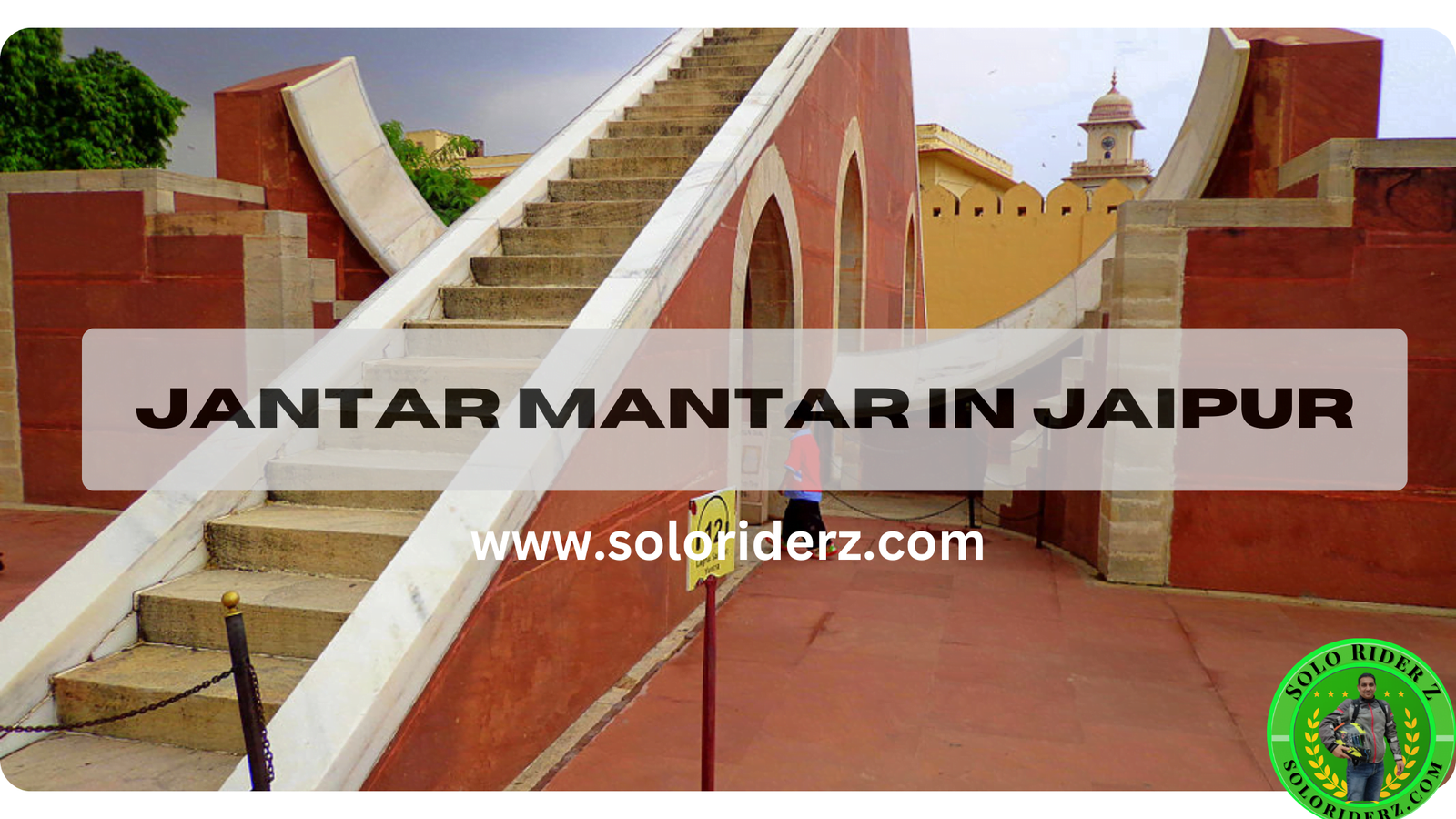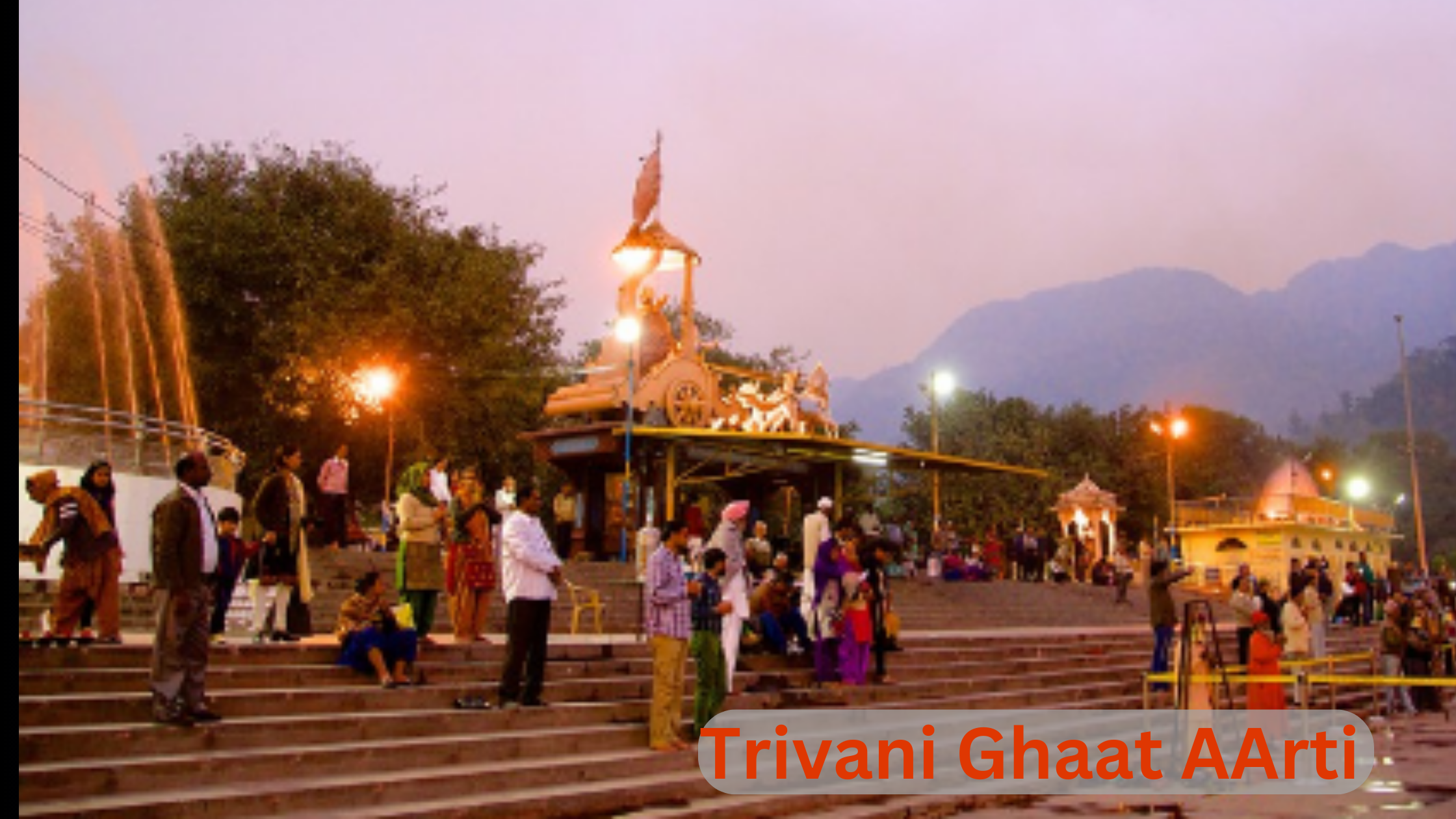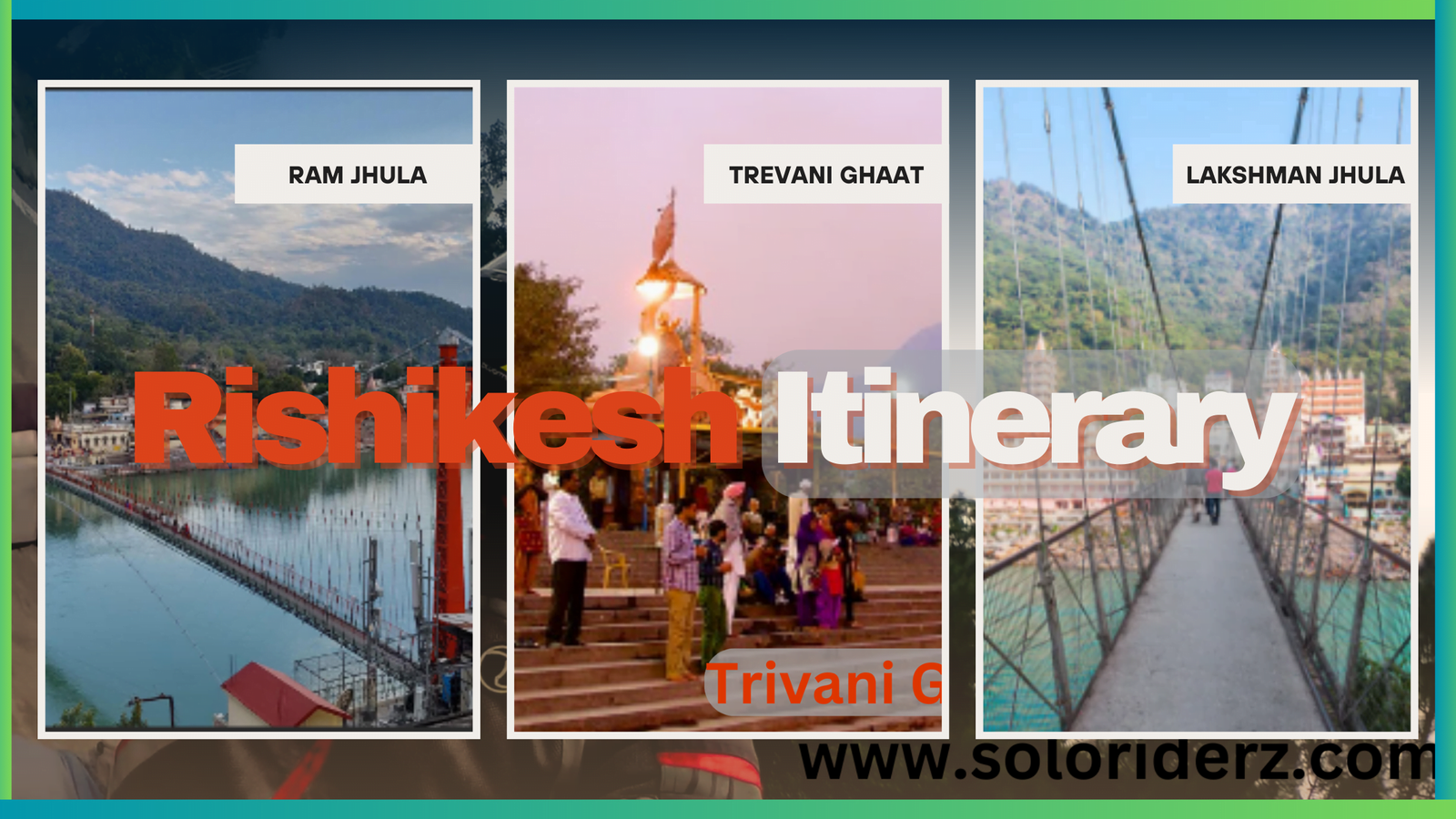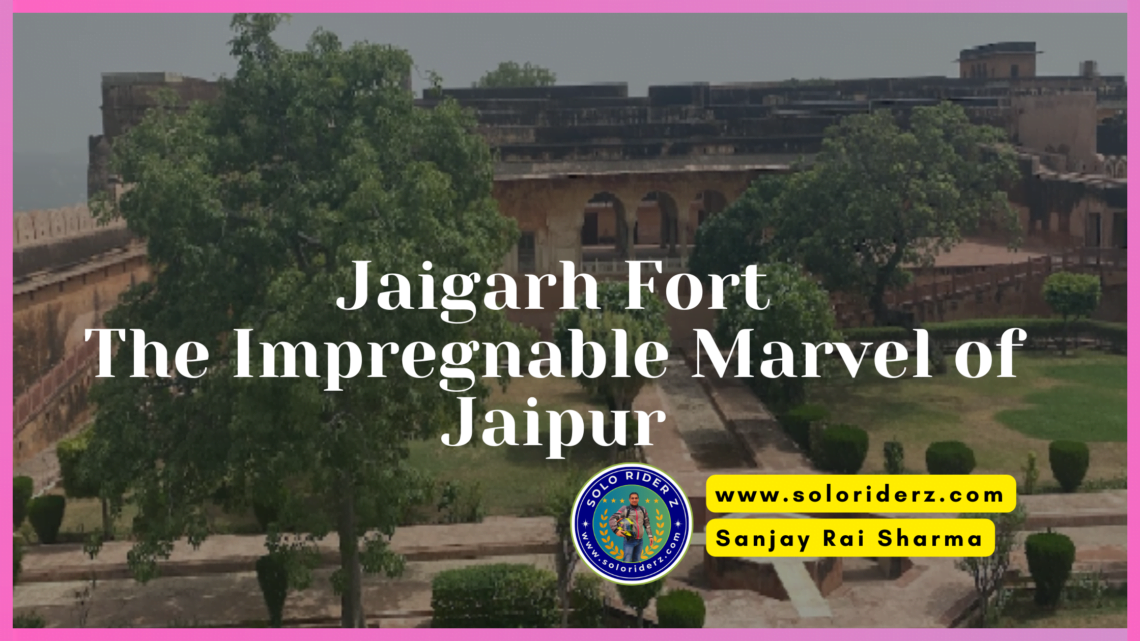
7 reasons Jaigarh Fort Marvel of Jaipur
- Jaigarh fort the unique marvel of Jaipur
- A Glimpse into History of Jaigarh Fort
- Jaigarh Fort is considered an architectural marvel for several compelling reasons
- Jaigarh Fort: The View from the Top
- Jaigarh Fort Today
- Tips for Planning Your Visit to Jaigarh Fort
- 1. Best Time to Visit:
- 2. Opening Hours:
- Here is a general idea of the entry fees:
- 3. Guided Tours:
- 4. Comfortable Footwear:
- 5. Photography Gear:
- 6. Sun Protection:
- 7. Hydration:
- 8. Exploration Time:
- 9. Nearby Attractions:
- 10. Local Cuisine:
- 11. Souvenirs:
- 12. Respect Cultural Sensitivities:
- 13. Evening Visits:
- 14. COVID-19 Guidelines:
- Nearby Attractions
- Events and Festivals at Jaigarh Fort
- Frequently Asked Questions (FAQs) About Jaigarh Fort
Jaigarh fort the unique marvel of Jaipur
Situated at the top of the majestic Aravalli Hills, with a view stretching over the Pink City of Jaipur, Jaigarh Fort stands tall as a testament to the bravery and skill of the Rajput rulers. Known as the “Fort of Victory,” it symbolizes strength, history, and incredible craftsmanship. Let’s explore the rich history and exciting highlights of Jaigarh Fort together!
A Glimpse into History of Jaigarh Fort
The historical background of Jaigarh Fort dates back to the early 18th century when Maharaja Jai Singh II, the founder of Jaipur, commissioned its construction. The fort, situated on the Cheel ka Teela (Hill of Eagles), was built between 1726 and 1739 to strengthen the defense of the region and protect the Amer Fort.
Jaigarh Fort served both military and royal purposes during its early years. Its strategic location atop the Aravalli range provided a commanding view of the surrounding landscape, making it an ideal stronghold for defense. The fort is also connected to Amer Fort through underground passages, enabling the royal family to escape in times of emergency.
The construction of Jaigarh Fort was part of a broader strategy to fortify the Amer region against potential invasions. The fort’s architecture reflects the military prowess of the Rajput rulers, featuring thick walls, watchtowers, and storage facilities for arms and ammunition.
One of the most famous aspects of Jaigarh Fort’s history is its association with the legendary ‘Jaivana Cannon.’ Commissioned by Maharaja Sawai Jai Singh II, this cannon is known to be one of the world’s largest wheeled cannons ever manufactured. The fort’s role as a repository for this massive artillery piece showcases its significance in the military history of Rajasthan.
Over the years, Jaigarh Fort has witnessed various historical events and battles, contributing to the rich tapestry of Rajasthan’s history. Today, it stands as a well-preserved testament to the military and architectural prowess of the Rajput rulers, drawing visitors from around the world to explore its historical significance.
Jaigarh Fort is considered an architectural marvel for several compelling reasons
- Strategic Location: Perched on the Cheel ka Teela (Hill of Eagles) of the Aravalli range, Jaigarh Fort enjoys a strategic location that provides a panoramic view of the surrounding landscape. The fort’s elevated position was crucial for military defense, offering an advantage to spot and thwart potential invaders.
- Impressive Layout and Design: The fort’s layout and design showcase the brilliance of Rajput architecture. The complex comprises a series of interconnected courtyards, palaces, and watchtowers. The well-thought-out design incorporates a network of water channels for storage and distribution, displaying the ingenuity of ancient engineering.
- Defensive Features: The thick red sandstone walls of Jaigarh Fort were designed to withstand attacks, making it an impregnable fortress. The defensive features include strategically placed watchtowers that served both surveillance and defensive purposes, allowing the fort’s defenders to spot enemies from a distance.
- Architectural Detailing: The fort exhibits intricate architectural detailing, including decorative elements, frescoes, and carvings that reflect the artistic sensibilities of the time. The detailing adds an aesthetic appeal to the fort, making it not only a military stronghold but also a visual delight.
- Connection with Amer Fort: Jaigarh Fort is linked to Amer Fort through well-engineered underground passages. This connection served both strategic and logistical purposes, allowing for coordinated defense and providing a secure route for the royal family to move between the two forts.
- Jaivana Cannon: The fort houses the legendary ‘Jaivana Cannon,’ which adds to its architectural significance. The cannon, one of the world’s largest wheeled cannons, showcases the technological advancements of the time and the fort’s capability to house such monumental pieces.
- Water Conservation System: The fort incorporates an advanced water conservation system with extensive water tanks. This system not only catered to the needs of the fort’s inhabitants but also demonstrated the foresight of the architects in managing precious water resources in a region known for its arid climate.
In summary, Jaigarh Fort’s architectural marvel lies in its strategic planning, defensive features, aesthetic detailing, and the integration of advanced engineering solutions, making it a testament to the rich architectural heritage of the Rajput era.
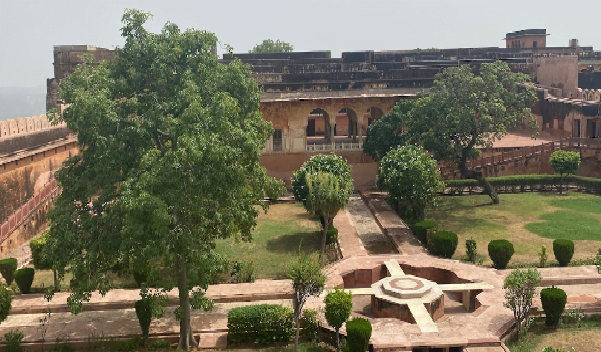
Jaigarh Fort: The View from the Top
Viewing Jaigarh Fort from the top offers a breathtaking and awe-inspiring experience. As you ascend to the upper reaches of the fort, the panoramic vistas unfold, providing a unique perspective of both the fort itself and the surrounding landscape. I was stunned when admiring Jaigarh Fort from its commanding heights.
- Spectacular Landscape: The elevated position of Jaigarh Fort affords visitors a sweeping view of the picturesque landscape below. Surrounded by the Aravalli hills, the fort provides a stunning backdrop against the natural beauty of the region.
- Architectural Grandeur: From the top, you can truly appreciate the architectural grandeur of Jaigarh Fort. The sprawling complex with its massive walls, watchtowers, and interconnected structures creates a striking visual spectacle. The intricate detailing of the fort’s design becomes more apparent, showcasing the skilled craftsmanship of the Rajput architects.
- Amer Fort Connection: The view from the top also allows you to observe the connection between Jaigarh Fort and Amer Fort. The presence of underground passages linking the two forts becomes evident, highlighting the strategic considerations that went into their construction.
- 360-Degree Perspective: As you stand atop the fort, you’ll enjoy a 360-degree perspective of the surroundings. The vast expanse of the landscape, including the nearby city of Jaipur, unfolds before your eyes, offering a sense of the fort’s dominance over its strategic position.
- Jaivana Cannon: If you have the opportunity to explore the areas around the Jaivana Cannon, the view from this section is particularly captivating. The cannon itself, positioned on a high platform, becomes a focal point against the backdrop of the Aravalli hills.
- Photographic Opportunities: The top of Jaigarh Fort provides numerous photo opportunities. Whether capturing the imposing architecture, the scenic landscapes, or the play of light and shadows on the fort walls, photography enthusiasts will find ample subjects to create memorable images.
- Sense of History: Standing at the highest points of Jaigarh Fort, there’s a palpable sense of history. Imagining the fort in its heyday, serving as a military stronghold and royal residence, adds a layer of historical significance to the visual experience.
In conclusion, viewing Jaigarh Fort from the top is a mesmerizing moment to experience our history, architecture, and nature. It offers a chance to appreciate the strategic foresight of its builders and provides a sensory feast for those seeking a deeper connection with Rajasthan’s cultural heritage.
Jaigarh Fort Today
Jaigarh Fort, standing proudly on the Cheel ka Teela (Hill of Eagles), continues to be a captivating destination for visitors today. Its current state reflects a harmonious blend of historical preservation and a welcoming atmosphere for tourists. Here’s a glimpse into Jaigarh Fort as it stands in the present day:
- Preservation Efforts: Jaigarh Fort has undergone meticulous preservation efforts to retain its historical grandeur. The restoration projects have focused on maintaining the structural integrity of the fort while safeguarding its unique architectural features.
- Visitor Experience: Today, the fort welcomes visitors with open gates, offering a journey back in time. Tourists can explore the various sections of the fort, from the impressive main gate to the sprawling courtyards and palaces, each narrating a chapter of Rajasthan’s rich history.
- Educational Signage: To enhance the visitor experience, informative signage has been strategically placed throughout the fort. These signs provide historical context, architectural details, and anecdotes, allowing visitors to gain a deeper understanding of the fort’s significance.
- Museum Displays: Certain sections of Jaigarh Fort now house museums that display artifacts, weapons, and historical memorabilia. These exhibits offer insights into the military prowess of the Rajput rulers and showcase the evolution of weaponry over the centuries.
- Cultural Events: Jaigarh Fort has become a venue for cultural events and exhibitions. Occasional events celebrate the region’s traditional music, dance, and art, adding vibrancy to the historical setting and providing tourists with an immersive cultural experience.
- Panoramic Views: Visitors can still enjoy the unparalleled panoramic views from the top of Jaigarh Fort. The elevated vantage point provides a breathtaking sight of the surrounding Aravalli hills, the nearby city of Jaipur, and the sprawling landscapes that stretch beyond the fort’s walls.
- Tourist Amenities: Infrastructure has been developed around Jaigarh Fort to cater to the needs of tourists. Facilities such as guided tours, souvenir shops, and refreshment areas ensure that visitors have a comfortable and enjoyable experience exploring the fort.
- Accessibility: Jaigarh Fort is easily accessible, allowing tourists to include it in their itinerary while exploring the historical and cultural attractions of Jaipur. The ease of access ensures that the fort remains a prominent destination for both local and international tourists.
In conclusion, Jaigarh Fort stands not only as a testament to the valor of the Rajput rulers but also as a living heritage site that invites modern-day explorers to step into the past. Its well-preserved architecture, coupled with a commitment to providing an enriching visitor experience, ensures that Jaigarh Fort continues to be a must-visit destination in the vibrant tapestry of Rajasthan’s historical wonders.
Tips for Planning Your Visit to Jaigarh Fort
Planning a visit to Jaigarh Fort promises a journey into Rajasthan’s regal history and architectural splendor. Here are some tips to ensure you make the most of your experience:
1. Best Time to Visit:
- Opt for a visit during the cooler months, from October to March, to enjoy pleasant weather and explore the fort comfortably.
2. Opening Hours:
- Jaigarh Fort is typically open from 9:00 AM to 5:00 PM. Plan your visit within these hours to have ample time to explore.
Here is a general idea of the entry fees:
- Indian Nationals:
- For adults: Typically ranges from INR 35 to INR 50 per person.
- Foreign Nationals:
- For adults: Generally ranges from INR 85 to INR 100 per person.
- Students and Senior Citizens:
- Reduced rates may be applicable for students and senior citizens with valid identification. This could be around INR 15 to INR 25.
- Camera and Video Camera Fees:
- If you plan to bring a camera, additional fees might be applicable. It could be in the range of INR 50 to INR 100.
Please note that these are approximate figures, and the actual fees might vary. Additionally, there may be special rates or discounts during certain times or for group visits. It’s advisable to check with the official website of Jaigarh Fort or local tourism authorities for the most up-to-date information on entry fees and any special offers.
3. Guided Tours:
- Consider hiring a local guide to gain deeper insights into the fort’s history, architecture, and hidden gems. Guides often share fascinating stories that enhance your overall experience.
4. Comfortable Footwear:
- Wear comfortable and sturdy footwear as you’ll be navigating through various sections of the fort, including inclined pathways and stairs.
5. Photography Gear:
- Bring your camera or smartphone to capture the stunning views, intricate architecture, and memorable moments. Photography is allowed, so seize the opportunity for remarkable shots.
6. Sun Protection:
- As the fort is located on the high elevated location. The sun’s rays comes directly, so i request you to carry sun protection essentials like sun glasses, a big hat or cap so that you may shield yourself from direct sun’s rays.
7. Hydration:
- Carry a water bottle to stay hydrated, especially if you plan to explore the fort extensively. There may be spots where you won’t find immediate access to refreshments.
8. Exploration Time:
- Allocate sufficient time for exploration. Jaigarh Fort has multiple sections, each with its unique features and stories. Plan for at least 2-3 hours to appreciate the fort thoroughly.
9. Nearby Attractions:
- Explore nearby attractions like Amer Fort, which is linked to Jaigarh Fort. Combining visits to these landmarks provides a comprehensive understanding of the region’s history.
10. Local Cuisine:
- After your fort exploration, indulge in local cuisine at nearby eateries. Try traditional Rajasthani dishes to complete your cultural experience.
11. Souvenirs:
- Look out for souvenir shops near the fort for mementos and handicrafts. Support local artisans by purchasing authentic Rajasthani keepsakes.
12. Respect Cultural Sensitivities:
- Respect the cultural sensitivities of the region. Dress modestly, particularly if you plan to visit any religious or sacred areas within the fort.
13. Evening Visits:
- Consider planning an evening visit if there are special events or cultural performances scheduled. Some attractions are beautifully illuminated after sunset.
14. COVID-19 Guidelines:
- Check for any specific COVID-19 guidelines or restrictions in place during your visit. Ensure you follow safety protocols for a secure and enjoyable experience.
By considering these tips, your visit to Jaigarh Fort will not only be informative but also a memorable exploration of Rajasthan’s rich cultural and historical heritage. Enjoy your journey back in time!
Nearby Attractions
Jaigarh Fort is situated in close proximity to several other fascinating attractions that collectively contribute to the rich historical and cultural tapestry of the region. When planning your visit, consider exploring these nearby attractions:
Amer Fort (Amber Fort):
Just a short distance away from Jaigarh Fort, Amer Fort is a magnificent structure renowned for its blend of Rajput and Mughal architecture. The two forts are connected by underground passages, allowing for a seamless exploration of both landmarks.
Jal Mahal:
Nestled in the midst of Man Sagar Lake, Jal Mahal is an architectural gem. The palace appears to float on the water’s surface and provides a picturesque view. While you cannot enter the palace, the surrounding area is perfect for a serene lakeside stroll.
Hawa Mahal (Palace of Winds):
Located in the heart of Jaipur, Hawa Mahal is a distinctive pink sandstone structure with intricately designed windows. It served as a vantage point for royal women to observe street festivals. The architectural marvel is a must-visit for its unique facade.
City Palace:
The City Palace in Jaipur is a grand complex that showcases a blend of Rajput, Mughal, and European architectural styles. Explore the museum, courtyards, and gardens to delve into the city’s royal history.
Jantar Mantar:
This UNESCO World Heritage Site is an astronomical observatory built by Maharaja Jai Singh II. Jantar Mantar features a collection of unique instruments designed for celestial observations, making it an intriguing destination for science and history enthusiasts.
Albert Hall Museum:
Situated in Ram Niwas Garden, the Albert Hall Museum is the oldest museum in Rajasthan. It houses a diverse collection of artifacts, including paintings, sculptures, and decorative arts, providing insights into the state’s cultural heritage.
Nahargarh Fort:
From the Nahargarh Fort you may see the complete view of Jaipur. You may take panoramic photo from here. The fort’s architecture and historical significance make it a compelling destination for those interested in Rajasthan’s regal past.
Galtaji (Monkey Temple):
Known for its natural water springs and a large population of monkeys, Galtaji is a complex of temples set amidst stunning surroundings. The Monkey Temple is a unique cultural and natural experience.
Jaipur Wax Museum:
For a different kind of cultural exploration, the Jaipur Wax Museum features lifelike wax statues of historical figures, celebrities, and cultural icons. It’s an entertaining and educational stop for all ages.
Sisodia Rani Ka Bagh:
A delightful garden palace dedicated to Sisodia queen, this Mughal-style garden is adorned with fountains, painted pavilions, and lush greenery, providing a tranquil escape.
These nearby attractions complement the visit to Jaigarh Fort, offering a comprehensive experience of Jaipur’s historical, architectural, and cultural heritage.
Folklore and legends of Jaigarh Fort
Jaigarh Fort, like many historical landmarks in Rajasthan, is steeped in folklore and legends that add a touch of mystique to its grandeur. These stories, passed down through generations, contribute to the cultural richness surrounding the fort:
- The Cursed Treasure:
- One intriguing legend suggests that Jaigarh Fort is home to a hidden, cursed treasure. According to the tale, whoever attempts to claim the treasure will face dire consequences. This mysterious narrative has fueled the imagination of treasure hunters and adventure enthusiasts over the years.
- The Echoing Walls:
- The massive walls of Jaigarh Fort are said to have remarkable acoustic properties. According to local folklore, if you stand at a specific spot and clap your hands, the sound echoes multiple times, creating an enchanting and almost musical experience. This phenomenon has contributed to the fort’s mystical reputation.
- The Tale of the Lost Queen:
- Legends speak of a hidden chamber within Jaigarh Fort where a queen, possibly from the royal family of Amer, was said to have taken refuge during a turbulent period. The exact location of this chamber remains a mystery, adding an air of romanticism to the fort’s history.
- The Ghostly Presence:
- Some locals believe that certain sections of Jaigarh Fort are haunted by the spirits of soldiers and royalty from the past. Visitors have reported eerie experiences, hearing faint whispers or sensing a mysterious presence, especially during the quiet hours of the night.
- The Curse of the Jaivana Cannon:
- The famous Jaivana Cannon, positioned atop the fort, has its own legend. It is said that the cannon carries a curse – any attempt to move it from its place would bring misfortune. This belief has deterred any efforts to displace the massive artillery piece.
- The Architect’s Sacrifice:
- An old legend suggests that during the fort’s construction, an architect made a personal sacrifice to ensure the fort’s strength and longevity. Some versions claim that the architect willingly buried himself alive within the foundation of the fort, believing that his sacrifice would protect the structure.
- The Benevolent Spirit:
- Contrary to the eerie tales, there’s a folklore about a benevolent spirit residing within Jaigarh Fort. This spirit is said to watch over the fort, ensuring its preservation and protecting it from harm.
These captivating tales and legends add layers of intrigue to Jaigarh Fort, turning it from a historical monument into a living repository of stories. Whether rooted in historical events or woven from the threads of imagination, these narratives contribute to the allure of Jaipur’s architectural gem.
Events and Festivals at Jaigarh Fort
Jaigarh Fort is not only a historical monument but also a venue for various events and festivals that add vibrancy to its ancient walls. Here are some of the events and festivals celebrated at Jaigarh Fort:
- Heritage and Cultural Events:
- Periodically, Jaigarh Fort hosts heritage and cultural events that showcase Rajasthan’s rich traditions. These events often include music performances, traditional dance, and art exhibitions, providing visitors with a glimpse into the state’s cultural tapestry.
- Sound and Light Shows:
- Many forts in Rajasthan, including Jaigarh, organize sound and light shows that narrate the history of the fort in an engaging way. The fort comes alive with illuminated visuals and narrations, creating a mesmerizing experience for the audience.
- Sawai Madho Singh’s Birthday Celebration:
- Sawai Madho Singh II, the founder of Jaigarh Fort, is honored on his birthday with special celebrations at the fort. These events may include cultural performances, historical reenactments, and ceremonies paying tribute to the legacy of the ruling Maharaja.
- Local Festivals:
- During major local festivals, Jaigarh Fort becomes a hub of activity. Festivities like Diwali, Holi, and other regional celebrations may attract locals and tourists alike. The fort’s architecture provides a unique backdrop for traditional rituals and cultural celebrations.
- Jaipur Literature Festival (JLF):
- While the main venue for the Jaipur Literature Festival is Diggi Palace, Jaigarh Fort is sometimes used as an extension for events and discussions. The fort’s ambiance adds a unique dimension to the literary festival, creating an inspiring setting for intellectual discourse.
- Historical Reenactments:
- To transport visitors back in time, Jaigarh Fort occasionally hosts historical reenactments of key events from its past. These performances, featuring actors in period costumes, provide an immersive experience of the fort’s historical significance.
- Music and Dance Festivals:
- Jaigarh Fort serves as a captivating venue for music and dance festivals. Whether it’s classical music, folk performances, or contemporary dance, the fort’s open spaces become stages for artistic expressions that resonate with the cultural heritage of Rajasthan.
- Art and Craft Fairs:
- Artisans and craftsmen often gather at Jaigarh Fort for special fairs showcasing traditional Rajasthani arts and crafts. Visitors can explore and purchase handcrafted items, textiles, and jewelry, contributing to the preservation of local craftsmanship.
These events and festivals not only breathe life into Jaigarh Fort but also offer visitors a chance to engage with the rich cultural heritage of Rajasthan. Whether you’re interested in history, literature, or the arts, Jaigarh Fort provides a dynamic backdrop for diverse cultural celebrations.
Conclusion
Jaigarh Fort stands as a living testament to Rajasthan’s rich history, blending architectural brilliance with military valor. As you explore the fort and its surroundings, immerse yourself in the cultural tapestry that has shaped this region for centuries
Frequently Asked Questions (FAQs) About Jaigarh Fort
- Q: What is the historical significance of Jaigarh Fort?
- A: Jaigarh Fort was built in the 18th century to strengthen the defense of the Amer region. It served both military and royal purposes, showcasing the strategic prowess of the Rajput rulers.
- Q: What is the entry fee for Jaigarh Fort?
- A: Yes, there is an entry fee to visit Jaigarh Fort. The fee may vary for Indian and foreign nationals, and additional charges may apply for cameras.
- Q: How long does it take to explore Jaigarh Fort?
- A: Plan for at least 2-3 hours to explore Jaigarh Fort thoroughly. The fort has multiple sections, each with its unique features and historical significance.
- Q: Can I hire a guide at Jaigarh Fort?
- A: Yes, guided tours are available at Jaigarh Fort. Hiring a guide can enhance your experience by providing insights into the fort’s history, architecture, and legends.
- Q: What are the nearby attractions to Jaigarh Fort?
- A: Nearby attractions include Amer Fort, Jal Mahal, Nahargarh Fort, Panna Meena ka Kund, and the Jaipur Wax Museum.
- Q: Are there any legends or ghost stories associated with Jaigarh Fort?
- A: Yes, several legends surround Jaigarh Fort, including stories of a cursed treasure, echoing walls, and ghostly apparitions. These tales contribute to the fort’s mystique.
- Q: Can I take photographs inside Jaigarh Fort?
- A: Generally, photography is allowed inside Jaigarh Fort. However, it’s advisable to check for any specific restrictions in certain areas and be mindful of other visitors.
- Q: Is Jaigarh Fort wheelchair accessible?
- A: The fort has uneven pathways and stairs, which may pose challenges for wheelchair users. Some sections may be less accessible, so it’s recommended to inquire about specific accessibility features.
- Q: Are there any special events or festivals at Jaigarh Fort?
- A: Jaigarh Fort hosts various events, including cultural festivals, sound and light shows, and historical reenactments. Check the event calendar for special occasions during your visit.
- Q: Can I purchase souvenirs near Jaigarh Fort?
- A: Yes, there are souvenir shops both within and near Jaigarh Fort where you can purchase traditional Rajasthani handicrafts, textiles, and artifacts.
Remember to check for the latest information and guidelines before planning your visit to Jaigarh Fort. Enjoy your exploration of this historical gem in Rajasthan!



